Texas Railroad History - Tower 63 - Mexia (Springfield)
A Crossing of the Trinity & Brazos
Valley Railway and the
Houston & Texas Central Railway
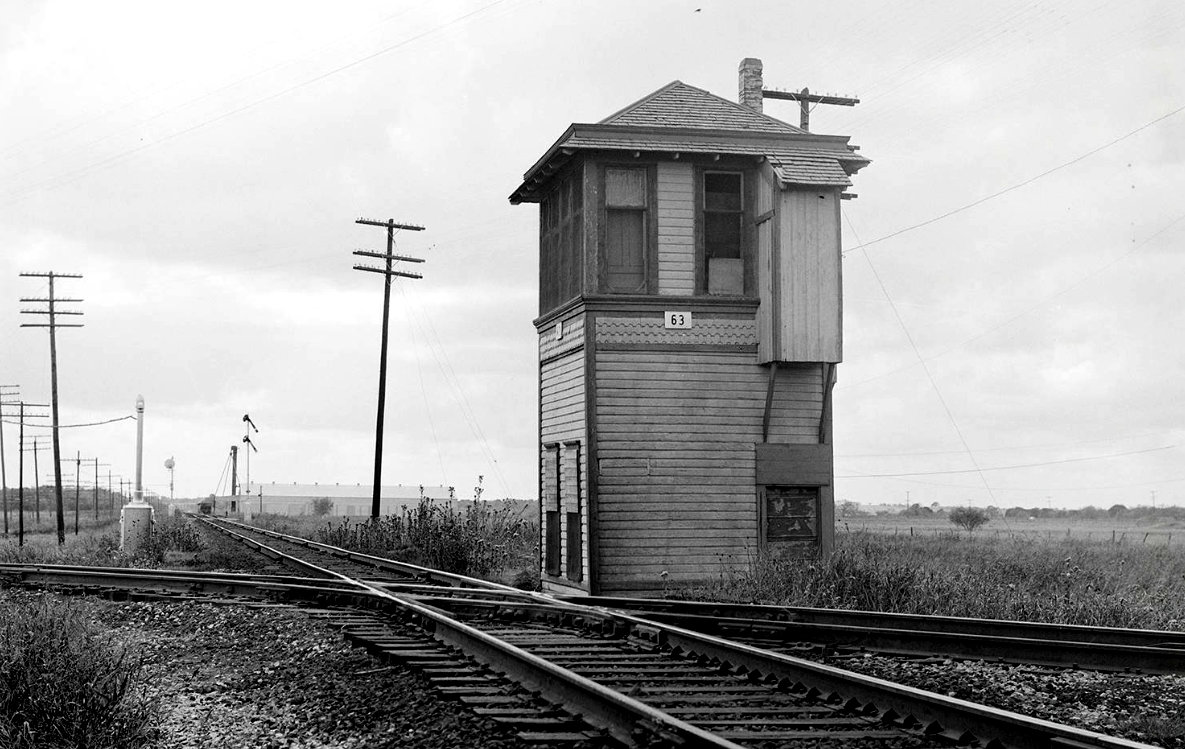
Above: Albert D. "Dean"
Hale took this photo of Tower 63 on October 24, 1961. The photo negative was
acquired by Everett DeGolyer Jr., who added technical and subject details on a
notecard stored with it. The view is south down the
Southern Pacific (SP) tracks with the Burlington - Rock Island (B-RI) tracks
crossing at an acute angle on a southeast (left) / northwest (right) heading.
The tower began operations on April 26, 1906, but by 1961,
it was no longer occupied as the crossing had been converted to a cabin
interlocking. Across the SP tracks from the tower, two white equipment cabinets
are visible, perfectly aligned from this angle. The pole is atop the
cabinet farthest from the camera;
the closer one most likely housed the manual interlocker controls that B-RI train crews
would use to set the signals to grant permission for their trains to cross. (DeGolyer Library,
Southern Methodist University; hat tip Dennis Hogan and Stephen Taylor)
 |
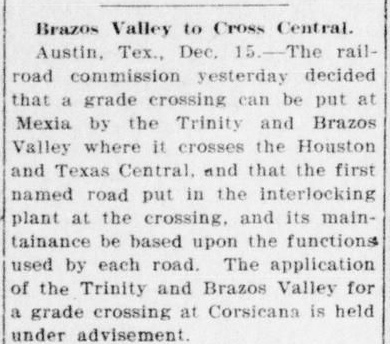
Above:
As the second railroad at the crossing, the interlocking at Mexia was to be installed by "the first named
road", the Trinity & Brazos Valley (T&BV). The "...grade
crossing at Corsicana..." became Tower 72.
(Waxahachie Daily Light, December 15,
1905) |
Above: Tom Kline describes his
photo..."It's a shot of the Mexia Turn headed back to Teague after crossing the SP. I do not know who the photographer was but he was the engineer on the local powered by a Fort Worth & Denver SD7 who took it while waiting for his brakeman to board the wooden, outside-braced Rock Island caboose. You can see him waving a highball as he steps aboard. This photo came from engineer Bob James, a longtime employee of the B-RI who believes the date to be in the early '60's..."
Since the Mexia Turn was headed back to Teague and had just crossed
the SP tracks, the brakeman was undoubtedly climbing aboard having just
set the interlocking controls to allow resumption of unrestricted
movements on SP's line. The Tower 63 crossing had been converted to a
manual cabin plant (operated by train crews) at least two decades
earlier. The tower remained standing but unoccupied, and it is highly
unlikely that it continued to house the interlocking plant after the conversion
to a cabin-type system. A trackside cabinet would provide adequate space for the
interlocker and place it closer to its manual controls.
 Left:
The Texas & New Orleans (T&NO) became SP's operating railroad for Texas and
Louisiana lines in 1934. This excerpt from a 1940 T&NO Employee Timetable shows
that at least by then (and perhaps earlier) Tower 63 had been converted to a
"Cabin Interlocking Plant" with the signals normally set for unrestricted
movements on the T&NO's tracks.
Left:
The Texas & New Orleans (T&NO) became SP's operating railroad for Texas and
Louisiana lines in 1934. This excerpt from a 1940 T&NO Employee Timetable shows
that at least by then (and perhaps earlier) Tower 63 had been converted to a
"Cabin Interlocking Plant" with the signals normally set for unrestricted
movements on the T&NO's tracks.
Named for the owner of an
1833 land grant, the town of Mexia was founded in 1870 by the Houston & Texas Central (H&TC)
Railway as it built north from Hearne toward
Denison and the Red River. Within fifteen years,
economic growth stimulated by the railroad had increased the town's population
to 2,000 residents as it became an important farming supply center. In 1904, the
Trinity & Brazos Valley (T&BV) Railway built southeast from
Cleburne through
Hillsboro, Malone and
Hubbard into Mexia. Construction stopped
there, remaining west of the H&TC tracks. The following year, the T&BV was
acquired by the Colorado & Southern (C&S) Railway as part of a grand plan conceived by
a member of the C&S Board of Directors,
Benjamin Franklin Yoakum.
B. F. Yoakum was a native Texan born in 1859
in Tehuacana, a small community near Mexia (the T&BV laid tracks within a mile of Yoakum's
birthplace.) Yoakum's
start in railroading came as a member of an International & Great Northern
(I&GN) track
gang. In 1886, he was hired as a clerk by the San
Antonio & Aransas Pass (SA&AP) Railway, and within a year, he had risen
to the position of Traffic Manager. Yoakum was so highly regarded that SA&AP
President Uriah Lott named the town of Yoakum for him. Yoakum quickly advanced
to become the General Manager of the SA&AP. He subsequently became its
Receiver when it entered bankruptcy in 1890. When the bankruptcy was settled in
1892, Yoakum moved on to become a Vice President of the Gulf,
Colorado & Santa Fe (GC&SF) Railway at age 33. In 1897, he moved again, to become General
Manager of the St. Louis & San Francisco ("Frisco") Railway in St. Louis.
Yoakum quickly rose to become the Chairman of the Board of the Frisco while simultaneously
becoming the Chair of the Executive Committee of the Board of Directors of the Chicago, Rock
Island & Pacific (CRI&P), effectively the CEO. Leading two major Midwest
railroads serving important cities such as Chicago, St. Louis and Kansas City
while also a member of the Board of the C&S placed Yoakum among the most
powerful railroad men in the U.S. Yoakum
was considered a marketing genius, so much so that his July, 1911 address to the
Texas Farmers' Congress at College Station is
available as a
book on Amazon!
Arranging for the C&S to buy the T&BV was not
part of Yoakum's original plan. His main problem was the lack of an in-house route to the
Gulf coast, so he had planned to have his Rock Island railroad build one. The Frisco and Rock Island lines
carried Midwest export commodities but their lines terminated in Fort Worth, 250
miles from Galveston. Thus, they had to hand traffic to SP and the GC&SF which had
routes from Fort Worth to Houston and Galveston. The I&GN opened a Fort Worth -
Galveston route via Houston in 1902 creating yet another option.
Yoakum wanted to build his own line from Fort
Worth to Houston and Galveston, and he wanted to route it via Dallas.
Passenger service to Dallas was a promising market; it had reached
42,000 residents in the 1900 Census and would more than double in size
by 1910. Yoakum's surveyors had found a low grade / low
curve route south from Dallas to Houston that would be superior to the lines of his competitors.
In 1902, Yoakum sought a Texas railroad charter to build from Fort Worth to Galveston via Dallas under the name
Chicago, Rock Island & Gulf (CRI&G). For compliance with Texas
law requiring railroads owning tracks in Texas to have headquarters in
state, the CRI&G was organized as
a Fort Worth-based subsidiary of the Illinois-based CRI&P corporation.
The CRI&G charter was granted, including a provision that consolidated
into the CRI&G three existing Rock Island subsidiaries in Texas (the one
in Fort Worth and two others in the Texas Panhandle.) It laid tracks from
Fort Worth to Dallas in 1903, but Yoakum delayed the extension to Houston and Galveston. The CRI&G railroad charter was
public information and it had created substantial consternation for the
other railroads in Texas. Attempting to prevent construction of yet
another route to the Gulf coast from north Texas, individual railroads
approached Yoakum to engage in negotiations seeking an alternative.
Right: This
article from the Navasota Daily Examiner
of May 16, 1902 announced that the Secretary of State and the Attorney
General had approved the CRI&G charter; it would next go to the
Legislature for approval. The article continues by listing the counties
specified in the charter through which the railroad would pass as it was
built from Fort Worth to Galveston. The list accurately tracked the line
that was eventually built, but beyond Dallas it was not a CRI&G
construction project. |
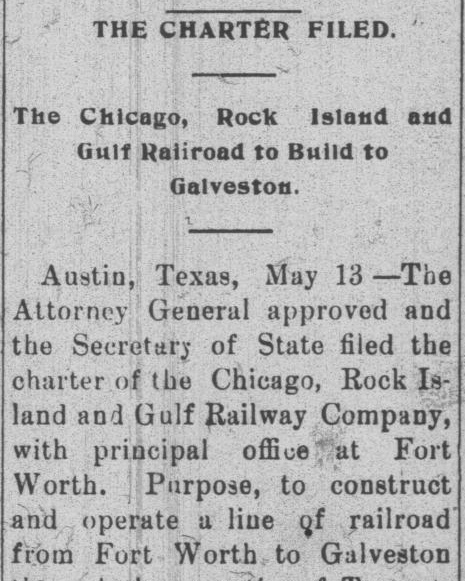 |
The railroads in Texas
rightfully viewed Yoakum's plan to build to Galveston as a serious threat,
but could they stop it? The GC&SF wanted to
expand the volume of traffic it was carrying for Yoakum between Fort Worth and Galveston.
It was, however, owned by the Atchison, Topeka & Santa Fe, a direct competitor to Rock
Island in the Midwest and Plains states, hence the GC&SF could not give Yoakum
everything he wanted. The I&GN offered to sell its line between Fort Worth and Houston,
but it was still under construction and Yoakum wasn't interested. It was SP Chairman E. H. Harriman
who had the most to lose. In 1883, SP had acquired the H&TC whose route from
Fort
Worth to Houston (via main line connection at Garrett) was carrying most of Rock
Island's Gulf coast traffic. Harriman was also aware that Rock Island surveyors
had identified a superior route between Dallas and Houston. Eventually, Harriman
capitulated, giving Yoakum essentially everything he wanted. The two men
negotiated a massive contract that would potentially reshape the course of Texas
railroading...but the contract required approval by the Railroad Commission of
Texas (RCT).
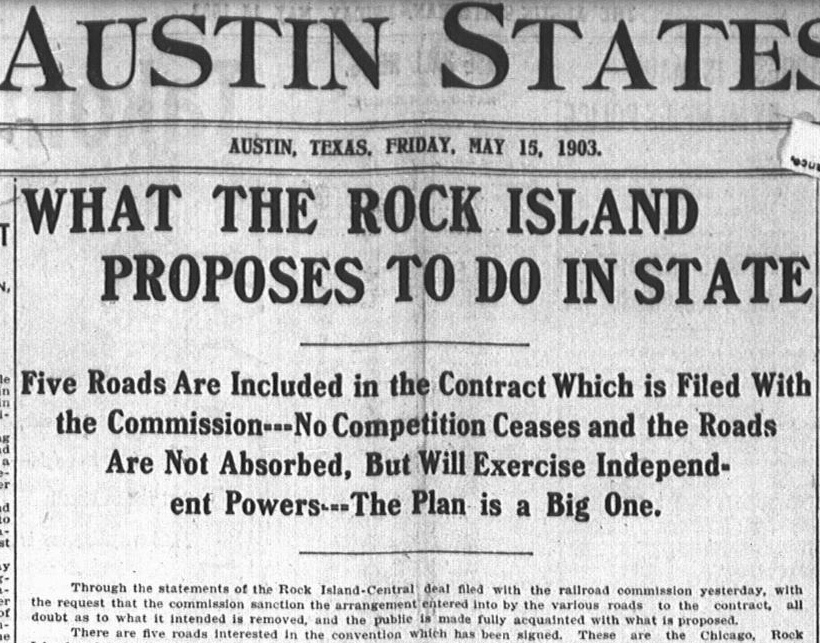 |
Left: The deal between Rock
Island and SP was
top-of-the fold front page news on
May 15, 1903 in the Austin Statesman.
The article called it the "Rock Island - Central deal"; "Central" had become a
nickname for SP due to its ownership of the H&TC. The article explained
that Yoakum had agreed to route Rock Island traffic to and from
the Texas Gulf coast exclusively on SP lines under full operational rights
granted by SP on four of its subsidiaries: the H&TC (Denison to Houston),
the Houston East & West Texas (Houston to
Lufkin and Shreveport), the Galveston, Houston & Northern (Houston
to Galveston) and the Texas & New Orleans
(Dallas to Beaumont and Houston to
Orange.)
RCT interpreted the
contract as ceding effective control of the four SP subsidiaries to
Yoakum, constituting in essence a partial merger or joint venture between SP and Rock Island. RCT
looked back at various laws passed by the Legislature granting railroad
mergers, finding there was little difference in the nature of the
details specified by the legislative enactments compared to the requirements
of the proposed contract. An Austin
Statesman story on May 21 explained that the proposed
contract does "...not require the Rock Island to build one mile of track
nor one house [depot] of any kind, and still the company acquires all of
the benefits and advantages as if the matter had come before the
Legislature without any disguise, as a straight merger proposition." The
story went on to predict that
this argument would "...form the several grounds upon which the
commission will refuse..." to approve the contract.
The Commission voted 2 - 1 to deny approval.
As a result, Yoakum changed strategy, aggressively moving to compete, rather than
cooperate, with SP. And Yoakum had a few cards up his sleeve waiting to be
played. |
Only a couple of weeks after submitting the contract to
RCT, Yoakum began to execute another component
of his larger vision. Yoakum saw the Lower Rio Grande Valley as a significantly
underserved area which could produce substantial traffic due to its agricultural
resources and growing population. The Valley was not connected to the national
rail network and Yoakum set out to fix that by chartering the St. Louis,
Brownsville & Mexico (SLB&M) Railway on June 6, 1903. He hired his
former boss, Uriah Lott, to build it, ostensibly from Harlingen
to Houston. The SLB&M was the first to be chartered by Yoakum under
the marketing guise Gulf Coast Lines
(GCL), a rail network envisioned to stretch from Brownsville
to New Orleans. Yoakum and his Frisco management team would buy or build the
individual GCL railroads and manage them collectively through the St. Louis
Trust Co., financially isolated from the Frisco. Yoakum correctly perceived that
due to the massive hurricane that had destroyed Galveston in 1900, Houston's
inland port would drive the economy to create the dominant commercial and
population center along the Texas coast. Houston was also halfway between
Brownsville and New Orleans, thus it became Yoakum's center of operations for
the GCL.
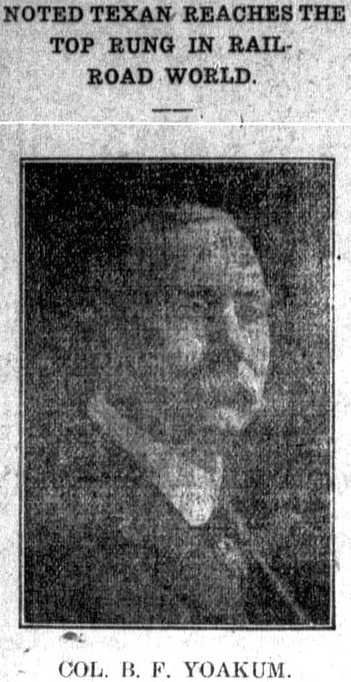 |
Right: By early 1904,
rumors were spreading that the T&BV would become part of Yoakum's Frisco
- Rock Island lines. Almost all of the details speculated were
incorrect!
The CRI&G line to Dallas was complete, but
Yoakum did not proceed with building the line to Houston authorized by its charter.
Instead, Yoakum enlisted the C&S to buy the T&BV to build and operate the Dallas - Houston route on Rock Island's survey.
As a C&S Director, Yoakum had befriended Edwin Hawley, a well known
railroad magnate and the principal owner / financier of the C&S. Teaming
with Hawley added financial heft to Yoakum's railroad play in Texas, and
having the C&S buy the T&BV gave Hawley skin in the game since it would
eventually yield a Denver - Galveston route. Through its Colorado
holdings and the Fort Worth & Denver City
(FW&DC, later FW&D) Railway, the C&S already had Denver - Fort Worth
service. The T&BV would simply close the gap to Houston. At Yoakum's
request, the C&S would later sell 50% of the T&BV to the Rock Island.
Yoakum
may have had one more card to play. In
1903, RCT suddenly began to question the legality of SP's acquisition of
the SA&AP eleven years
earlier
(facilitated in 1892 by the SA&AP's bankruptcy Receiver, Mr. B. F.
Yoakum!) RCT sued SP and the court ruled that SP must divest the SA&AP
which was currently selling bonds to finance a line from Alice
to Edinburg in the Lower Rio Grande Valley.
Independent from SP, the SA&AP lacked the resources to continue
construction to the Valley, building only as far south as Falfurrias. This
gave Yoakum's SLB&M control of the Valley,
regardless of whether he was behind the whole affair (which seems
likely.) Harriman was incensed and spitefully vowed to parallel any new tracks
built by Yoakum in Texas.
Left: In later years when Yoakum announced that he would
soon retire from the railroad business, the Mexia Weekly Herald
of October 3, 1912 ran a story on his legacy. Had Yoakum begun using the title "Colonel" to
compete with his friendly rival Col. Ned Green? |
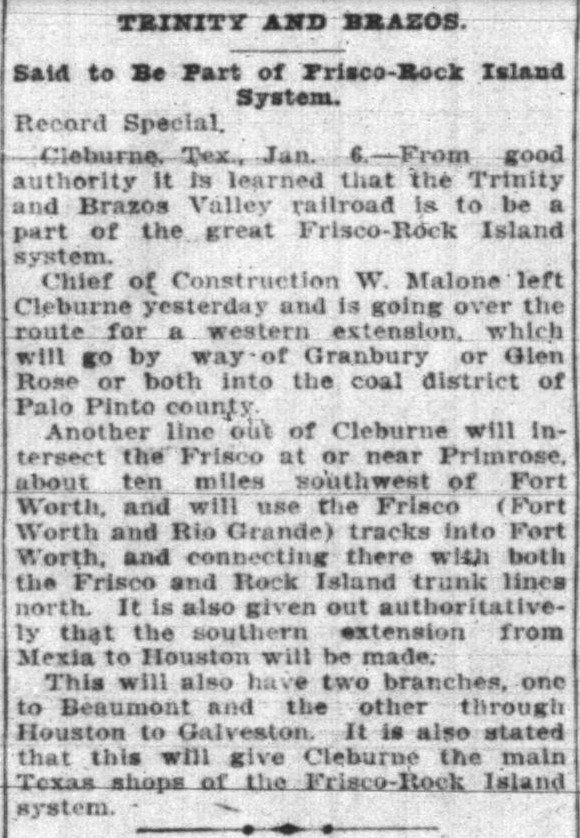
Fort Worth
Record & Register, January 7, 1904 |
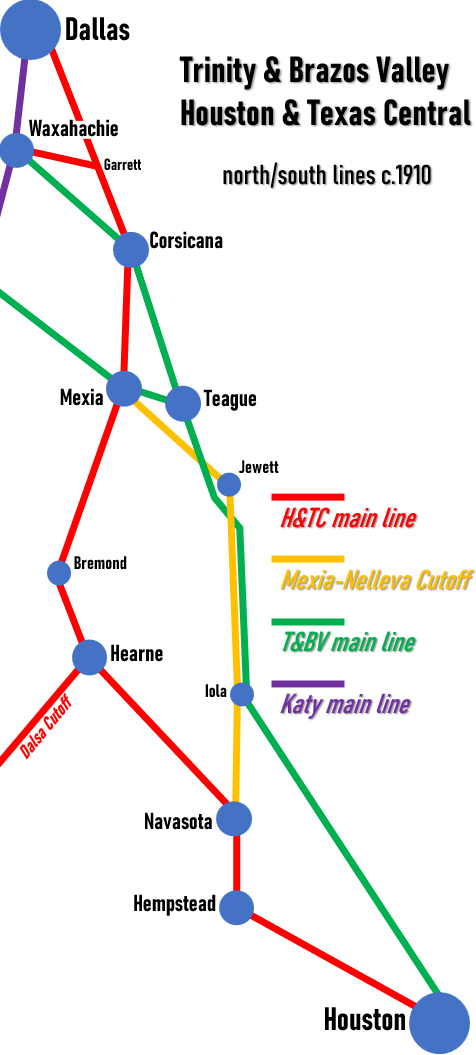 |
On August 1, 1905, the C&S bought
the T&BV. Yoakum was able to modify the charter to authorize building east
from Mexia to the community of Brewer. From there he would build north to
Dallas and south to Houston on the survey that Rock
Island had conducted. Remaining west of H&TC's tracks for two miles south through
Mexia, the T&BV crossed over at Springfield, named for a
nearby ghost town that had been the original
county seat of Limestone County. This crossing became the site of Tower 63 in
1906. The T&BV's construction continued east from Springfield to Brewer, a town
that Yoakum incorporated as the city of Teague (his mother's maiden name); it would host a
yard and maintenance shops. At the north end of the line, Yoakum obtained
trackage rights on the Missouri, Kansas
& Texas ("Katy")
Railroad at Waxahachie, eliminating the need to build all the way
into Dallas. Yoakum's new line was designed to be faster and more efficient than SP's route via Hearne and Mexia, creating a serious problem
for Harriman. Before it was finished, Harriman was already building a
competing line.
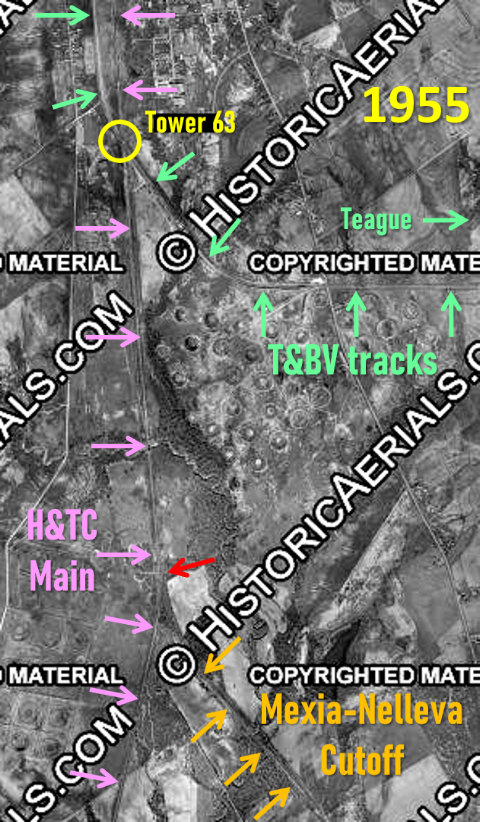
Far
Left: Harriman's threat to parallel any lines Yoakum
built was no joke. SP opened a
competing line in 1907 known as the Mexia-Nelleva Cutoff. It shortened SP's
route between Houston and Mexia by branching off the main line at
Nelleva on the northern outskirts of
Navasota and proceeding north
to Mexia via Jewett. Between Iola and Jewett, the Cutoff ran literally side by
side with the T&BV for 42 miles. The north end of the
Cutoff reconnected to the H&TC main line 1.5 miles south of
Tower 63.
In addition to Tower 63, the H&TC and T&BV crossed in three other
locations, all of them grade-separated. Near Jewett, the lines crossed
twice; the H&TC went over the T&BV south of Jewett and went under the
T&BV north of Jewett. On the north side of
Corsicana, the T&BV passed beneath the H&TC about 1,300 feet
southeast of the
Tower 165 interlocker. In Waxahachie, T&BV
trains exercising trackage rights on the Katy railroad crossed the H&TC at grade at
Tower 67.
Left:
((c) historicaerials.com) In this 1955 aerial image taken south of
Mexia, the red arrow identifies the north end connection between the
H&TC main line (pink arrows) and the Mexia-Nelleva
Cutoff (orange arrows.) [The Cutoff grade is visible but there are no
tracks; it was
abandoned in 1933.]
A mile
and a half farther north, the H&TC crossed the T&BV tracks (green
arrows) from Teague at Tower 63 (yellow circle.) West of Tower 63, what had been the T&BV's
original main
line to Cleburne only went a couple of miles into Mexia in 1955. The
last of the tracks west of Mexia had been abandoned in 1942.
|
 |
Left:
Trains had been operating between Cleburne and Teague since March 16, 1906,
a few weeks before Tower 63 was completed. The first Houston - Fort
Worth train via Teague and Cleburne ran January 28, 1907 using trackage
rights on the GC&SF between Cleburne and Fort Worth. (Houston Post, January 28, 1907)
Right:
T&BV's first Houston - Dallas train ran on July
1, 1907 as reported that afternoon by the
Waxahachie Light.
Yoakum had a busy month in August, 1905. The T&BV acquisition by the
C&S occurred on August 1, followed by the sale of 50% of the T&BV to
Rock Island. Yoakum chartered the Galveston Terminal Railway (GTR) on
August 29 and assigned its ownership to the T&BV. Two days later,
Yoakum chartered the
Houston Belt & Terminal (HB&T) as a switching railroad that would also build a
union passenger station in downtown Houston. Yoakum
railroads owned 75% of the HB&T; the GC&SF owned the other 25%. As the
GTR and HB&T were being built, the T&BV tracks reached Houston in 1907
but did not build to Galveston. SP's Galveston, Houston & Northern
subsidiary initially provided the T&BV with trackage rights from Houston
to Galveston. The T&BV switched to GC&SF trackage rights in April, 1908
as part of the deal for rights between Algoa
and Houston for the SLB&M. |
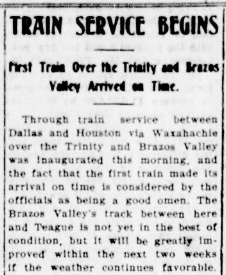 |
A month after trains had begun running between Cleburne
and Teague, Tower 63 was commissioned by RCT on April 26, 1906 to control the T&BV / H&TC
crossing south of Mexia. It had a 12-function mechanical interlocker, the
typical minimum arrangement for a simple crossing consisting of a home signal,
distant signal and derail in each of the four directions. Approach route and
detector locking was added to the plant in 1924. The photos of the tower at the
top of this page suggest that it was built by SP as it resembles other SP towers
in Texas erected both earlier (e.g. Tower 26) and
later (e.g. Tower 100.) RCT
records list H&TC as the railroad with responsibility for tower operations, typically a
strong clue as to which railroad built it. Since the crossing did
not exist until after 1901, RCT regulations assigned the capital
expense for the tower and interlocking plant entirely to the T&BV. This gave the
T&BV the right to take the lead for design and construction of the tower, but
they undoubtedly deferred to SP which had vastly more experience in building and
operating interlocking towers. The recurring operations and maintenance expenses
were split equally between the two railroads since they each
accounted for half of the interlocking functions. It was relatively rare for an
interlocking plant to retain precisely the same function count for decades as
functions were typically added and subtracted over time, usually associated with
connecting tracks and signaling changes. Tower 63's function count never
changed, at least through the final comprehensive list of interlockers published
by RCT in 1931.
 |
Construction and approval of the Tower 63
interlocking may have been the fastest on record. RCT's interlocking
order was issued on December 14, 1905. These two Houston Post articles
(left, March 17, 1906
and right, April 28,
1906) report the progress. In the
Waxahachie Daily Light of April 17, 1906, construction was
reported complete, thus it took about ten days for RCT's inspector to
travel to Mexia to inspect and approve the system for operations. |
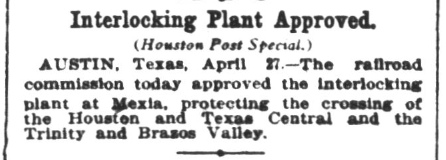 |
Although
the T&BV carried Frisco, Rock Island and FW&DC passengers and freight between north
and south Texas, traffic levels were insufficient to fully support the
railroad's operations. The T&BV's financial situation deteriorated, perhaps in
part from the fallout of Yoakum's retirement from the railroad business. The
T&BV only served Dallas and Fort Worth via trackage rights, and there were no
other towns of any significant size on the T&BV, certainly none able to provide
the traffic volume that the T&BV needed to sustain its operations. A lengthy receivership for the T&BV began in 1914 but the railroad was able to remain operational
under the supervision of the bankruptcy court. It was not until 1930 that the
T&BV came out of bankruptcy, its assets acquired by the Burlington-Rock Island (B-RI) Railroad.
The B-RI was a
newly formed corporation jointly and equally owned by the Rock Island and the Chicago, Burlington & Quincy
(CB&Q), the two railroads that had each owned
half of the T&BV. The CB&Q's ownership stemmed from its acquisition of
the C&S in 1909. The CB&Q assigned its FW&DC subsidiary to operate its half of the B-RI. The FW&DC and Rock Island
alternated managing the B-RI in five-year intervals beginning with the Rock
Island in 1930.
The superior
north/south route built by the T&BV enabled the B-RI to operate successfully, but
only by diligently cutting routes that were not profitable. This resulted in the
relatively quick abandonment
of the remainder of the former T&BV tracks starting with the
30 miles between Hillsboro and Cleburne in 1932. Another 25 miles was abandoned
between Hubbard and Hillsboro in 1935. As a result
of these abandonments, sometime in the 1930s Tower 63 was downgraded to a cabin
interlocker, which also saved money. The downgrade would have reduced its
function count from twelve to ten, eliminating the distant signals in both
directions on the B-RI line. Distant signals would not be needed for the B-RI
because the cabin interlocker was normally lined for unrestricted movements on
SP's tracks. Trains on the B-RI were always
required to stop at the crossing, hence a fixed distant sign was sufficient to
remind approaching B-RI trains to stop (and if they didn't, the derail would
stop them!) Once stopped, a train crewmember would disembark to set the
interlocker controls to grant permission to cross the SP tracks. This would
simultaneously trigger a distant signal on the SP tracks that the crossing was
occupied. The signals would be reset by the crewmember after the train had
crossed (and the crewmember would return to his train -- see Tom Kline's photo
at the top of the page.) The obvious advantage of a cabin interlocker on lightly
used lines was that it eliminated the tower staffing costs paid by both
railroads; train crews handled the controls. In this case, the disadvantage was
that B-RI trains always had to stop, but that was an insignificant penalty since
the train from Teague to Mexia and back operated infrequently.
The 23 miles from Mexia to Hubbard
was abandoned in 1942, leaving the remaining tracks as
simply a short branch off the B-RI main line at Teague to serve a few remaining
businesses in or near Mexia. The tracks remained in place until abandonment in 1976,
about twelve years after the B-RI company had ceased to exist. It had been forced into foreclosure by its two owners,
Rock Island and Burlington, as a simple means to dissolve the corporation. Its
assets were taken over by the
two railroads who agreed to share maintenance expenses and unlimited rights to
operate over the B-RI tracks. Rock Island's bankruptcy in 1980 left Burlington
Northern (successor to the CB&Q) as the sole operator of the Waxahachie -
Houston line through its FW&D subsidiary. In 1996, Burlington Northern merged with Santa Fe to form
Burlington Northern Santa Fe (BNSF), which continues to operate the line. The
original H&TC route through Mexia is now operated by Union Pacific (UP) which
acquired SP in a merger in 1996.
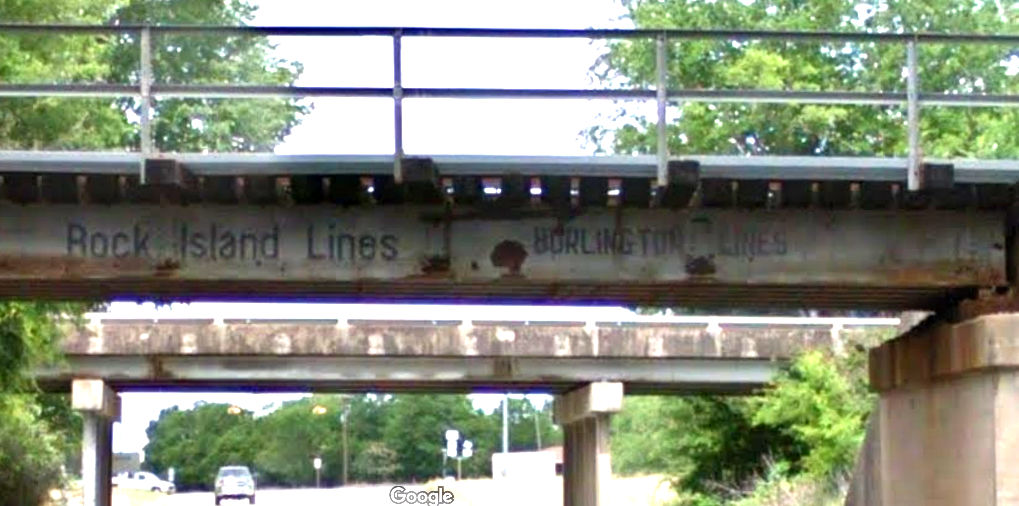
Above: In May, 2018, a Google
Street View camera caught this remnant of the B-RI on the side of the BNSF rail
bridge over US 190 at North Zulch. The bridge in the background elevates
Farm-to-Market (FM) Road 39 over US 190. Approximately 71 miles of the Cutoff was acquired
by the Texas Highway Department as a right-of-way for FM 39 between Iola and the
southeast outskirts of Mexia. Whether this track section required bridges in
the early days is unknown. Both bridges are present in 1955 aerial
imagery.
Below: South of Jewett,
the T&BV made a lengthy S-curve. When the Cutoff was built, it made a
grade-separated crossing over the T&BV
through the center of the curve. Since both railroads ran
side-by-side north and south of the curve, it appears that the T&BV chose to
implement the curve simply for the purpose of reducing the grade. This
Google Street View image from April, 2021 shows
the west-facing view taken from FM 39 -- formerly the Cutoff -- where BNSF's former T&BV
tracks pass beneath the highway.
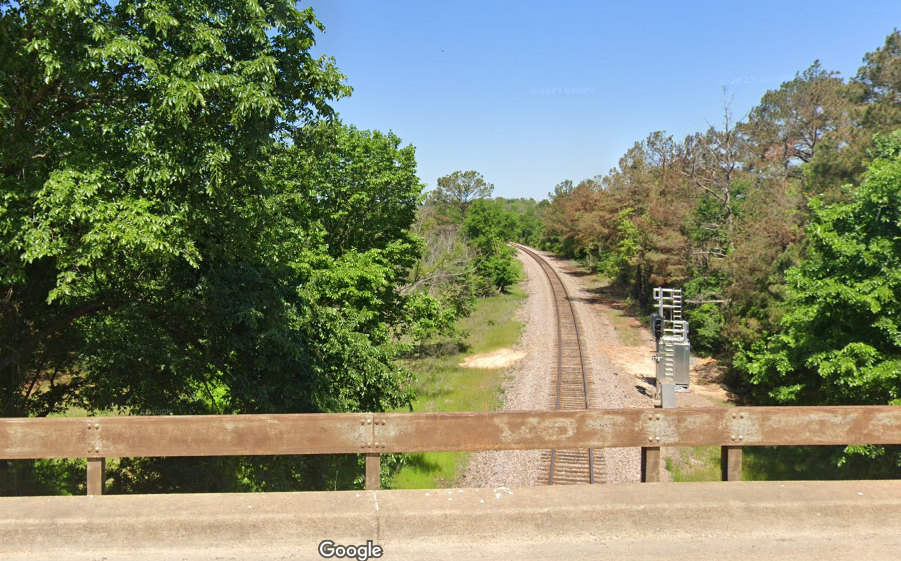
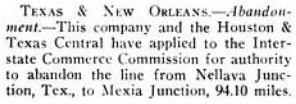 |
Left: In 1927,
SP leased the H&TC to the T&NO which was
destined to become the operating railroad for SP's Texas and Louisiana
lines. In 1932, T&NO and H&TC jointly applied to abandon the
Mexia-Nelleva Cutoff; the rails were removed in 1933. There was no local
commerce on the Cutoff, and the T&BV line was stiff competition. The
opening of the Dalsa Cutoff between Hearne
and Flatonia in 1914 meant that the
Mexia-Nelleva Cutoff no longer carried any SP traffic between Dallas and
Southern California that previously moved on or off SP's Sunset Route at
Houston. (Railway Age, May 21,
1932) |
Below:
These two images are precisely aligned by geographic coordinates. In the 1962
image ((c)historicaerials.com), Tower 63 is still physically intact (upper right) casting a short shadow to the north. The B-RI still
operated into Mexia from Teague hence the crossing remained in service. The B-RI
traffic level was miniscule compared to the SP line; at least two decades
earlier (per 1940 SP employee timetable) the tower had been downgraded to a
cabin interlocker. The 1962 image also shows that SP had a
turntable and roundhouse located 200 yards southwest of the tower accessible
from SP's main line between Tower 63 and the Mexia-Nelleva Cutoff. The 2022 Google Earth image shows that
UP's former SP tracks remain in place, but all
traces of the tower, the B-RI tracks, the turntable and the roundhouse have been
obliterated. The area is now occupied by Eagle Mountain Tree Farm, Inc.
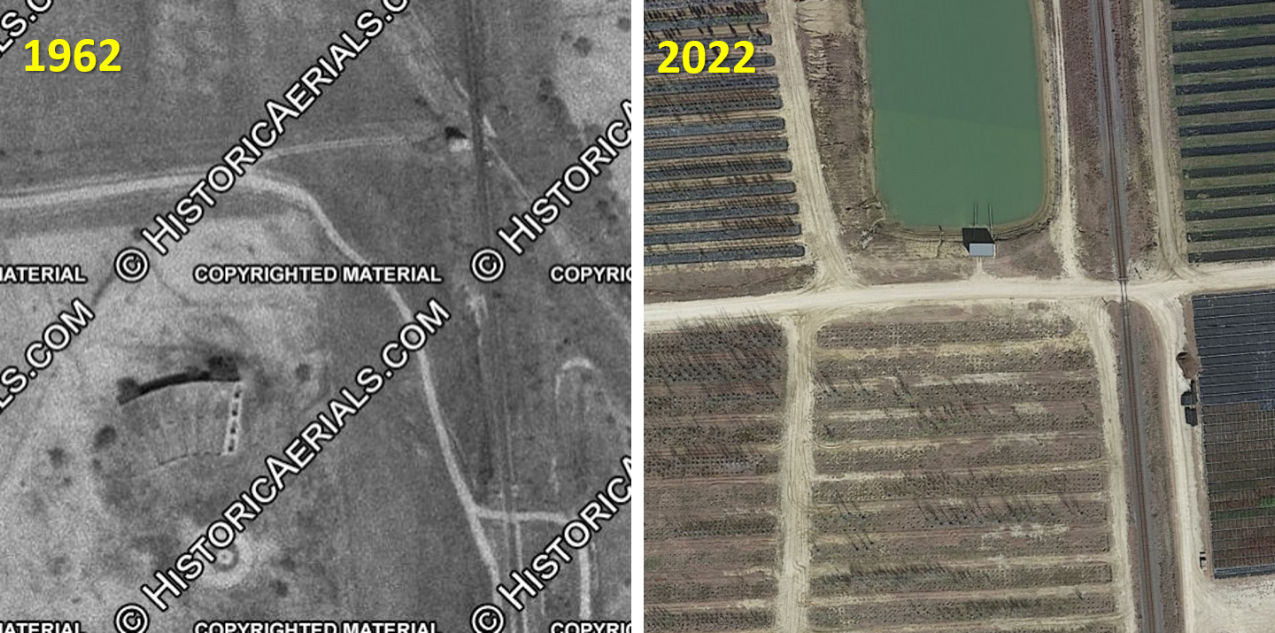
Right: Jim King's photo from c.1998 looks
northwest along FM 39 where it passed beneath the BNSF tracks three
miles northwest of Jewett. The underpass was narrow because when the
Cutoff needed to tunnel through an existing T&BV fill toward Mexia
in 1907,
the resulting underpass was only
wide enough for a single-track railroad.
When the Texas Highway
Department built FM 39 atop the Cutoff, they could either live with the
existing width or fund a rebuild of the B-RI tracks passing overhead. They
made the best of it, but the end result was still too narrow
to meet their standards unless reduced speeds were mandated with plenty
of warning signs deployed. By 2005, the entire underpass had been
rebuilt (below, Google
Street View 2023.) In the 2011-2012 timeframe, FM 39 was rerouted
northwest
of the underpass to curve around the north side of a new mining
operation.
 |
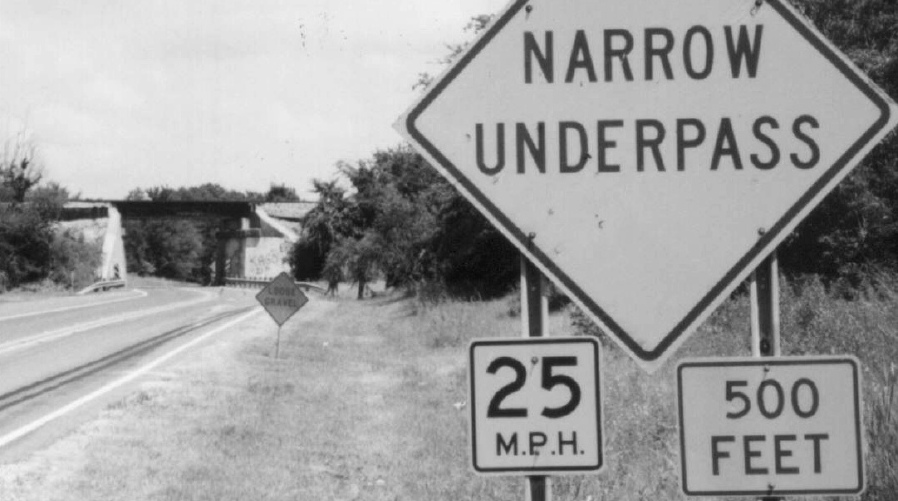 |



















